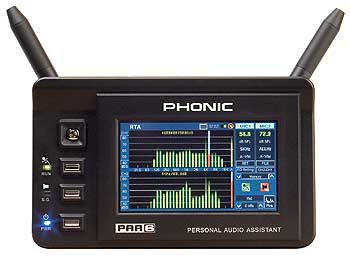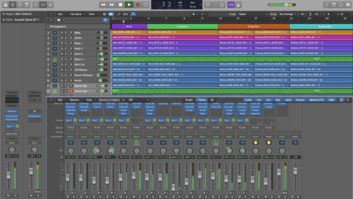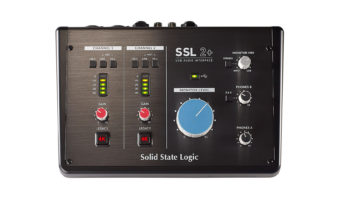
The PAA6 features an LCD touchscreen and intuitive GUI.
The PAA6 is Phonic’s latest offering in its series of Personal Audio Assistant test gear. The PAA6 augments the 31-band RTA, SPL, polarity and RT60 measurement abilities of the PAA2 and PAA3 (reviewed in the January 2006 Mix) with a full-color LCD touchscreen; stereo operation; Fast Fourier Transform (FFT); THD + Noise; and Scope, Phase and LEQ functions. The PAA6 weighs approximately one pound, and it’s about the size of a paperback book.
Looking Good
A 480×272 LCD touchscreen dominates the PAA6’s front panel. Controls include power on/off, run/stop, signal generator on/off and a navigation joystick. On the top panel are two balanced XLR line inputs, an XLR line out and a receptacle for the included stylus. Two measurement microphones are recessed alongside the body and pivot outward for use. The bottom panel features a USB connector, DC power inlet and SD memory card slot. A rechargeable lithium-ion battery (which provides up to three hours of operation), a DC adapter and a padded case are included.
The PAA6 powers up with a main menu screen. Tap on an icon for the desired function, and the PAA6 opens it. The function is not active until you manually select Run from either the touchscreen (the little running man) or the hardware button. (It would be nice if there was a choice of default that would open the app in Run mode.) Kudos to Phonic for making the OS easy: It provides access to most functions without requiring a visit to the manual, and signal-generator parameters are available from the main screen of any application.
Onscreen buttons activate or deactivate each channel, while a display indicates mic or line input. When only one channel is active, that channel occupies the entire screen. At the top of all screens are a battery indicator, clock and calculator. Most of the applications feature a Set button for setting mic or line input, response time and weighting (A, B, C or off).
An SD card slot is provided for file storage, but getting your data out of the box is important. However, the unit did not deliver on this important point. At press time, Phonic had not yet released software that enabled real-time operation via PC, and I was unable to interface the unit successfully with a PC running Windows XP or Vista for file transfer. FFT, RTA and RT60 measurements can be stored to dedicated memory slots as .txt files, but right now the only way to get them out of the PAA6 would be to store them on an SD card and use a card reader attached to your PC to access the files.
Testing, 1-2-3
The PAA6 is packed with useful functions that any pro looking for hard data will enjoy. I liked how the RTA can be set to octave, 2/3, 1/3 and 1/6-octave resolution, which I found useful for matching my system’s graphic EQ. A yellow arrow indicates the peak band, and tapping any frequency bar in the RTA brings its SPL to a numeric indicator. Click on EQ Setting to display the reciprocal EQ you’ll need to flatten room response. When RTA data is stored to memory, the reciprocal EQ is also stored.
The phase checker actually indicates the number of degrees of phase difference between left and right channels, proving to be very useful for head alignment of analog tape machines or evaluating the phase relationship between paired mono compressors or EQs. I could easily locate wiring problems using the polarity checker; by switching the input to “mic,” you can make a loudspeaker part of the test chain. When polarity is correct, “Phonic the Audio Guy” smiles at you on the screen. When polarity is reversed, he frowns.

LEQ measures equivalent continuous noise level and displays the results as SPL for 10 frequency bands, measured over a period of time ranging from a few seconds to 48 hours.
By far the most interesting (and fun) capability of the PAA6 is THD+Noise. Connect the output from the PAA6 to a destination device, and the output of that device is fed back into the PAA6. You can evaluate the unity gain point (which is not always where the manufacturer says it is) or observe changes in distortion while input level or input frequency is varied.
I’m Fond of Phonic
I found the PAA6 to work as advertised, although the lack of a PC interface leaves room for improvement. The unit encompasses a multitude of essential audio functions in a compact, easy-to-use package. Installers and live sound engineers will find it invaluable, but it also makes an important addition to the toolkit of any recording engineer or studio.
Steve La Cerra is Mix’s sound reinforcement editor.







